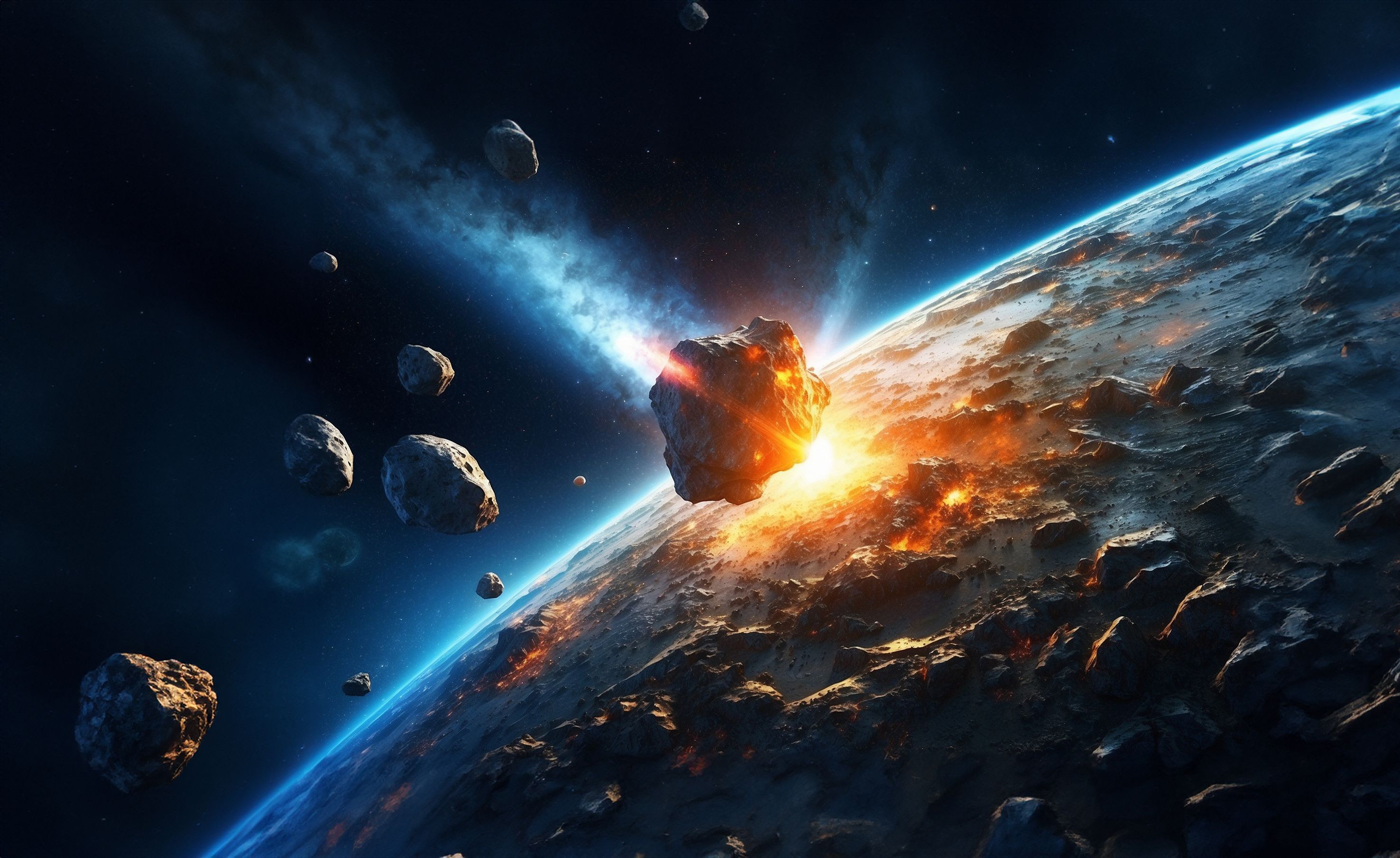Asteroids as Near-Earth Objects: A Detailed Near-Infrared Look into Composition and Origins
A comprehensive study of small near-Earth objects (NEOs) using spectroscopy reveals composition, source regions, and rotational properties. The research identifies S-complex asteroids as the most abundant and introduces a new subclass within this complex, yielding detailed information on the characteristics and origins of these celestial bodies.
Near Earth object (NEO) on collision course with Earth © Visualmind - stock.adobe.com

Understanding small near-Earth objects (NEOs) is crucial, as these bodies are closely related to the meteorites that frequently fall to Earth. Unlike larger objects, their collisions with Earth, while not capable of causing mass extinctions, can result in significant local damage. This study presents the findings of a detailed photometric and spectroscopic survey of small NEOs, focusing on their composition, source regions, and rotational properties. Asteroids are generally considered to be larger in diameter than meteoroids and are several meters in diameter up to several kilometers (1–3). The larger asteroids could cause catastrophic destruction to earth if they ever collide with us (3).
Detailed Findings
The research was conducted by a team of scientists from the Planetary Science Institute in Tucson, AZ, University of Arizona, Lowell Observatory in Arizona, Southwest Research Institute in Boulder, Colorado, Brown University in Providence, Rhode Island, and University of Maryland in College Park, Maryland. This research involved a seven-year survey using advanced spectroscopic and photometric techniques. The study included near-infrared (0.7–2.5 μm, 700–2500 nm) spectra of 84 NEOs with a mean diameter of 126 meters and photometric data of 59 NEOs with a mean diameter of 87 meters.
Read More: A Recent Spectral Analysis of Primitive Asteroids
Composition and Classification
The study revealed that S-complex asteroids are the most prevalent among the small NEOs, making up approximately 66% of the objects studied. The composition analysis indicated that most of these S-complex asteroids have compositions consistent with LL-chondrites, a type of stony meteorite. Additionally, the researchers identified NEOs with spectral characteristics that suggest they belong to a new subclass within the S-complex, called Sx-types. These Sx-types could be hidden within the C- or X-complex due to their weak absorption bands, potentially caused by the presence of metal or shock darkening.
An S-complex asteroid is a category of asteroids characterized by their silicate-rich composition. These asteroids are primarily composed of silicates and metals, such as iron and magnesium, and often have a relatively high albedo (reflectivity). The S-complex encompasses several subtypes of asteroids, including S-type, Sa-type, Sk-type, Sq-type, and Sr-type, which differ slightly based on variations in their spectral features. The spectral characteristics of S-complex asteroids show strong absorption features near 1 and 2 micrometers, indicative of silicate minerals like olivine and pyroxene. These features make S-complex asteroids distinguishable from other asteroid types, such as the C-complex (carbonaceous) and X-complex (metallic or enstatite chondrite-like) (1–4).
Source Regions
The dynamical modeling of the NEOs' orbits showed that the majority, about 83%, originated from the ν6 resonance, 16% from the 3:1 resonance, and a mere 1% from the 5:2 resonance. This distribution helps explain the low number of H-chondrites, as the regions producing these chondrites contribute less to the population of small NEOs (1).
Rotational Properties
The photometric study provided insights into the rotational periods and lightcurve amplitudes of the NEOs. The analysis showed no clear trend between the axis ratio and the absolute magnitude or rotational period of these objects. This finding suggests a complex interplay of factors influencing the rotational characteristics of small NEOs.
Significance and Future Research
The results of this study are consistent with previous research involving larger NEOs, reinforcing the understanding of the distribution and composition of small NEOs. The introduction of the Sx-type subclass highlights the need for more detailed spectral analysis to accurately classify these objects. Future research could focus on expanding the sample size and utilizing more advanced techniques to further refine the understanding of small NEOs (1).
The comprehensive study of small NEOs offers significant insights into their composition, origins, and rotational properties. The findings underscore the importance of continued research and monitoring of these objects, which, while small, play a crucial role in understanding the dynamic environment of near-Earth space and the potential hazards they pose (1).
References
(1) Sanchez, J.A., Reddy, V., Thirouin, A.; et al. The Population of Small Near-Earth Objects: Composition, Source Regions, and Rotational Properties. Planet. Sci. J. 2024, 5 (6), 131. DOI 10.3847/PSJ/ad445f
(2) Golovich, N., On the Need for a Near-Earth Object Characterization Constellation in Low-Earth Orbit. arXiv 2023, 2301,10348. https://doi.org/10.48550/arXiv.2301.10348
(3) Robert, L. NASA's Most Wanted: The 5 Most Dangerous Asteroids to Earth Countdowns, LiveScience, 2024, June 18. https://www.livescience.com/space/asteroids/nasas-most-wanted-the-5-most-dangerous-asteroids-in-the-solar-system (accessed 2024-07-01).
(4) DeMeo, F. E.; Burt, B. J.; Marsset, M. Connecting Asteroids and Meteorites with Visible and Near-Infrared Spectroscopy. Icarus, 2022 380, 114971. DOI: 10.1016/j.icarus.2022.114971
AI Shakes Up Spectroscopy as New Tools Reveal the Secret Life of Molecules
April 14th 2025A leading-edge review led by researchers at Oak Ridge National Laboratory and MIT explores how artificial intelligence is revolutionizing the study of molecular vibrations and phonon dynamics. From infrared and Raman spectroscopy to neutron and X-ray scattering, AI is transforming how scientists interpret vibrational spectra and predict material behaviors.
Real-Time Battery Health Tracking Using Fiber-Optic Sensors
April 9th 2025A new study by researchers from Palo Alto Research Center (PARC, a Xerox Company) and LG Chem Power presents a novel method for real-time battery monitoring using embedded fiber-optic sensors. This approach enhances state-of-charge (SOC) and state-of-health (SOH) estimations, potentially improving the efficiency and lifespan of lithium-ion batteries in electric vehicles (xEVs).